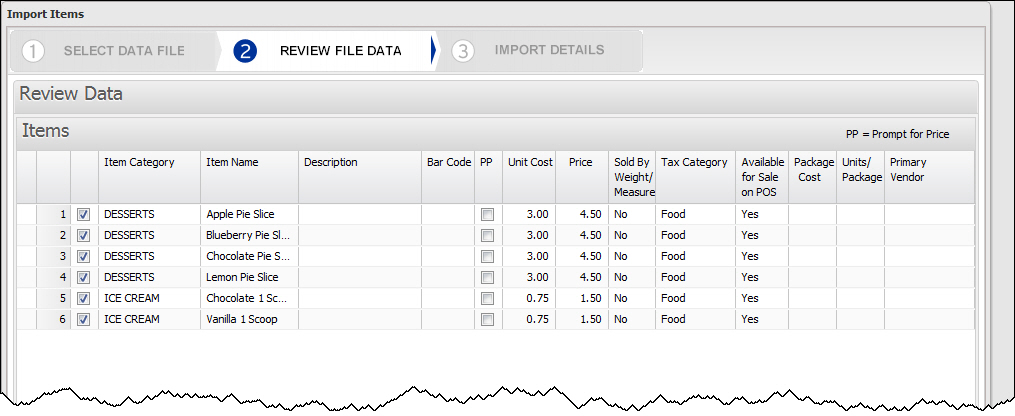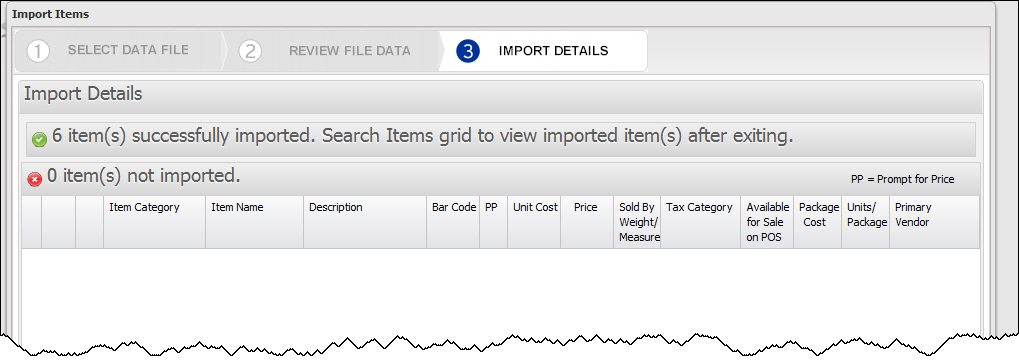| Description |
You can use an Excel or .CSV file to transfer the information to our system. Before doing an item import, you must have at least one tax category set up and one tax category selected as your default.
-
Please make sure your import file has 999 items or less in it. If you have more than 999 items, you will need to separate your master file into smaller files and then import them one file at a time.
-
Also, make sure that you have entered values for all of the required fields (Category, Item Name, Price).
-
When you begin your import, we will check your import file to ensure that there are no more than 999 items in your file and that all of the required fields have a value in them. If either of these "pre-tests" fail, the system will alert you.
-
As of NCR Silver version 4.5, you can now identify what modifier group the item is modified by. You can Assign up to 5 modifier groups to an item when using the Silver back office item import template.
-
The item import tool will edit any information for existing items, so every time you do an import you need to make sure that all of the information for existing items is correct. This means you can edit information using the import tool, but if you miss a box on the import of an existing item, that field or flag will be empty once imported. A best practice is to complete an item list export before importing so that you start with the most current information.
|

|
If you will sell items that have different tax categories, such as food, alcohol, general merchandise, etc., go ahead and create those tax categories first. Then, ensure you have the same exact name for the tax categories in your import file, and the system will assign all your items to your selected tax categories during the import process.
|
To import items:
-
Select INVENTORY > CATEGORIES & ITEMS and then click the Import Items button to display the Import Items screen.
-
Review the sample file on the screen, as well as the instructions for each field in the file.
-
Click Download Template to download the file template. (Shown at the end of this page)
-
Copy your inventory data into the sample file or modify an existing item list to match the format of the sample file. Save this file to your local computer with a name you will recognize. Ensure your data matches up with the appropriate column headers. Also, make note of the required fields.
-
Click Browse to Select File and select your inventory data file, and click Open.
|

|
The system will do 2 pre-tests on your import file. The first will be to count the number of items in your file. Make sure you have no more than 999 items in your import file. If you have more than 999 items, the system will alert you to separate your list into multiple files. The second test will be to make sure that all of the required fields have a value in them. If a required field is blank, the system will alert you to fix this in your import file and try again.
|
-
Click Review Item List at the bottom of the screen and review the data in your inventory file when it displays on the screen. When the screen refreshes, you may see rows of your data displayed with red exclamation points at the beginning of the row. This means that there was an error in that row that the system could not resolve. Click on the red exclamation point for each row to see the error(s) on that row. You can edit the information on the screen, or if you have multiple errors, you may choose to cancel your current import, go back to fix the errors in your source file, and begin the import process again with your updated file.

-
Make any edits to the data on the screen, and when you are satisfied with the data, make sure the check box is selected for each item you want to import. REMEMBER THAT AN ITEM IMPORT WILL UPDATE ANY INFORMATION THAT HAS CHANGED FOR EXISTING ITEMS.
-
Click Import Item List at the bottom of the screen. A message appears, indicating the number of items you are about to import. Click Yes to start the import.
-
When the import is finished, the Import Details screen displays the results of the import, including the number of items that were successfully imported and the number of items that could not be imported (these are usually duplicates).

-
Review the inventory records that were not imported, so you can make the necessary corrections to your file and import them again.
-
Click Exit at the bottom of the screen to close the Import Items screen.
-
Click  to display the newly-imported items. to display the newly-imported items.

keywords: importing items, importing data
|
|
|---|


